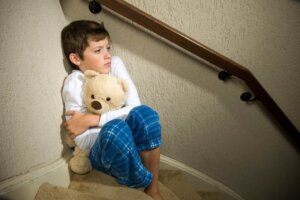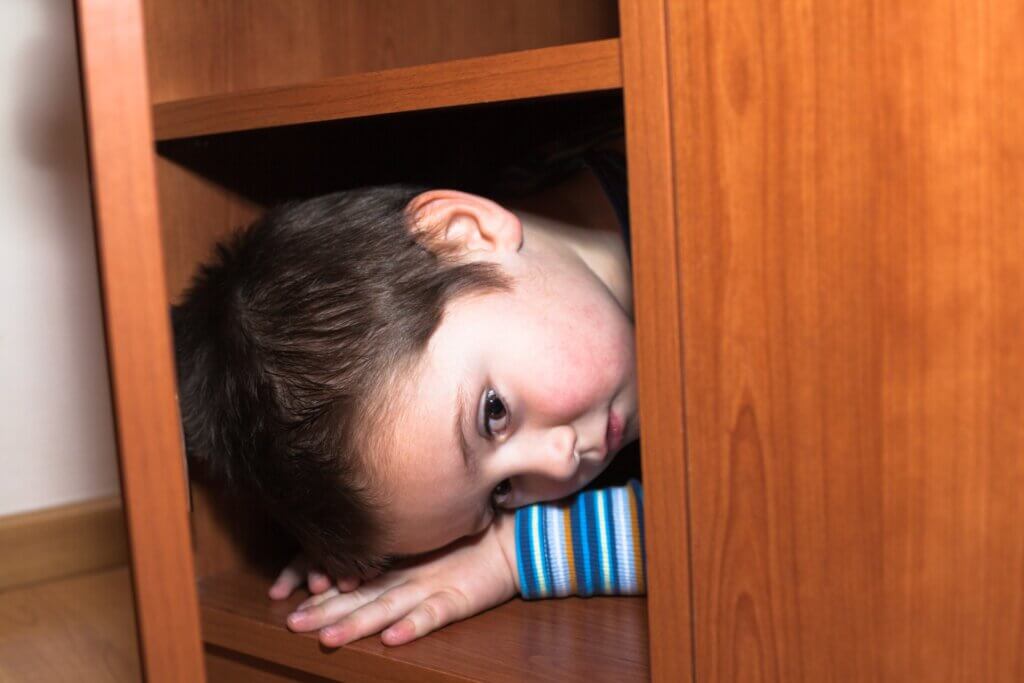Fear of Strangers in Children: What You Should Know

Fear of strangers in children is completely normal. It’s part of a survival mechanism, in which attachment, parental teachings, and the social context all play a part.
It’s believed to appear around 6 months of age and consolidates around a year. However, parents should be vigilant if the episodes are normative or if they’re a sign of a larger problem.
It’s natural for parents to develop concerns regarding their little one’s early interpersonal explorations. All babies have the instinct to mistrust those with whom they don’t have a bond, so in general, this shouldn’t arouse major distress. We’ll talk more about it and we’ll show you some indicators that stray from normative behavior.
Causes of fear of strangers in children
The most solid theory that accounts for the causes of fear of strangers in children stipulates that it’s an adaptive function. That is, it regulates the approach and exploration actions for the consolidation of the emergent attachment. The little one develops a bond with the people who are closest to them, as these provide security and protection.
Under this perspective, the fear of strangers in children is completely normal. It’s for this reason that many will choose to stay quiet, hide, cry, or show a fearful attitude toward people they still don’t know very well. Fear can be reinforced and increased by other factors, which can cause normative behaviors to evolve into a problem.
For example, a study published in Health & Place found that parental fears are passed on and take away from the independence in their little ones’ fears. If the parents are prone to mistrust strangers and manifest pathological attitudes towards these encounters, then the behavior is assimilated without objection by the younger ones. The influence of the parents is, therefore, a factor to consider.
Other experts point out that restrictive parental rules about playing outside translate into greater distrust of strangers. That is, the children of parents who grant less freedom when playing outdoors tend to develop fear and rejection toward strangers. Taking these variables into account, fear of strangers in children is less frequent in the following contexts:
- Children who’ve had experience in daycare
- Little ones who usually interact with other children their age
- Home experiences with different adult friends other than their parents
- Dozens of accumulated hours playing outside
- Positive experiences with strangers while in public
- Attendance at birthday parties, school gatherings, and other celebrations
Apart from this, we reiterate that fear at this stage is natural. It usually has its critical point around one year of age, and gradually disappears after two years, at least under normal conditions, as the child’s own personality and possible traumas can further extend these attitudes. Sometimes they’re a sign of an anxiety disorder.
Fear of strangers in children: When fear is anxiety

As researchers note, there’s a fine line between normative fear of adults in children and atypical behaviors that are related to anxiety. Childhood anxiety is very common, so much so that most episodes start at this stage. Some experts estimate that up to 8% of the child and adolescent population suffer from an anxiety disorder.
The disorder is very broad, and it can be difficult to diagnose because it’s characterized by signs that are considered normal at this stage. It can be encouraged by many variables, although the influence of the family environment plays a leading role. In this regard, there’s evidence that maternal depression increases fear in children; one that in many cases leads to episodes of anxiety in them.
A relationship has also been found between social phobia in mothers and the development of social anxiety disorder in children. The traumas that they’ve had in terms of interpersonal relationships can also be translated into the manifestation of episodes. Most cases last one to two years, although they may arise again in puberty or adolescence.
What to do to mitigate the fear of strangers in children?

It’s not opportune to accelerate the process of adaptation of interpersonal relationships in the little ones. Everyone has their time and experience, not to mention their baseline personality at all times (extroversion vs. introversion). Despite this, there are a couple of things you can do to monitor or accompany this behavior. We’ll leave you with some ideas:
- Don’t leave your little one 100% alone with strangers for their first few encounters. Your presence will give him a sense of security.
- Introduce friends and family whenever you can at home. This is the place where your child feels most comfortable, and they’ll be most receptive to interaction.
- Don’t pressure them to quickly make friends or connect with the children, youth, and adults they meet.
- Remember that your little one can read your verbal and non-verbal cues during interactions. So, stay calm so they can do the same.
- Bring an object of great value to your little one (a toy, a blanket) when meeting new people.
These practical tips will be of great help when it comes to enhancing children’s interpersonal skills. If you detect that your little one develops symptoms such as changes in their breathing rate, palpitations, sweating, tremors, and pathological distress, don’t hesitate to consult with a professional. It’s likely that they’re temporary episodes, but a qualified psychologist can channel the problem in order to overcome it.
Fear of strangers in children is completely normal. It’s part of a survival mechanism, in which attachment, parental teachings, and the social context all play a part.
It’s believed to appear around 6 months of age and consolidates around a year. However, parents should be vigilant if the episodes are normative or if they’re a sign of a larger problem.
It’s natural for parents to develop concerns regarding their little one’s early interpersonal explorations. All babies have the instinct to mistrust those with whom they don’t have a bond, so in general, this shouldn’t arouse major distress. We’ll talk more about it and we’ll show you some indicators that stray from normative behavior.
Causes of fear of strangers in children
The most solid theory that accounts for the causes of fear of strangers in children stipulates that it’s an adaptive function. That is, it regulates the approach and exploration actions for the consolidation of the emergent attachment. The little one develops a bond with the people who are closest to them, as these provide security and protection.
Under this perspective, the fear of strangers in children is completely normal. It’s for this reason that many will choose to stay quiet, hide, cry, or show a fearful attitude toward people they still don’t know very well. Fear can be reinforced and increased by other factors, which can cause normative behaviors to evolve into a problem.
For example, a study published in Health & Place found that parental fears are passed on and take away from the independence in their little ones’ fears. If the parents are prone to mistrust strangers and manifest pathological attitudes towards these encounters, then the behavior is assimilated without objection by the younger ones. The influence of the parents is, therefore, a factor to consider.
Other experts point out that restrictive parental rules about playing outside translate into greater distrust of strangers. That is, the children of parents who grant less freedom when playing outdoors tend to develop fear and rejection toward strangers. Taking these variables into account, fear of strangers in children is less frequent in the following contexts:
- Children who’ve had experience in daycare
- Little ones who usually interact with other children their age
- Home experiences with different adult friends other than their parents
- Dozens of accumulated hours playing outside
- Positive experiences with strangers while in public
- Attendance at birthday parties, school gatherings, and other celebrations
Apart from this, we reiterate that fear at this stage is natural. It usually has its critical point around one year of age, and gradually disappears after two years, at least under normal conditions, as the child’s own personality and possible traumas can further extend these attitudes. Sometimes they’re a sign of an anxiety disorder.
Fear of strangers in children: When fear is anxiety

As researchers note, there’s a fine line between normative fear of adults in children and atypical behaviors that are related to anxiety. Childhood anxiety is very common, so much so that most episodes start at this stage. Some experts estimate that up to 8% of the child and adolescent population suffer from an anxiety disorder.
The disorder is very broad, and it can be difficult to diagnose because it’s characterized by signs that are considered normal at this stage. It can be encouraged by many variables, although the influence of the family environment plays a leading role. In this regard, there’s evidence that maternal depression increases fear in children; one that in many cases leads to episodes of anxiety in them.
A relationship has also been found between social phobia in mothers and the development of social anxiety disorder in children. The traumas that they’ve had in terms of interpersonal relationships can also be translated into the manifestation of episodes. Most cases last one to two years, although they may arise again in puberty or adolescence.
What to do to mitigate the fear of strangers in children?

It’s not opportune to accelerate the process of adaptation of interpersonal relationships in the little ones. Everyone has their time and experience, not to mention their baseline personality at all times (extroversion vs. introversion). Despite this, there are a couple of things you can do to monitor or accompany this behavior. We’ll leave you with some ideas:
- Don’t leave your little one 100% alone with strangers for their first few encounters. Your presence will give him a sense of security.
- Introduce friends and family whenever you can at home. This is the place where your child feels most comfortable, and they’ll be most receptive to interaction.
- Don’t pressure them to quickly make friends or connect with the children, youth, and adults they meet.
- Remember that your little one can read your verbal and non-verbal cues during interactions. So, stay calm so they can do the same.
- Bring an object of great value to your little one (a toy, a blanket) when meeting new people.
These practical tips will be of great help when it comes to enhancing children’s interpersonal skills. If you detect that your little one develops symptoms such as changes in their breathing rate, palpitations, sweating, tremors, and pathological distress, don’t hesitate to consult with a professional. It’s likely that they’re temporary episodes, but a qualified psychologist can channel the problem in order to overcome it.
- Brooker RJ, Buss KA, Lemery-Chalfant K, Aksan N, Davidson RJ, Goldsmith HH. The development of stranger fear in infancy and toddlerhood: normative development, individual differences, antecedents, and outcomes. Dev Sci. 2013;16(6):864-878.
- Ding, D., Bracy, N. L., Sallis, J. F., Saelens, B. E., Norman, G. J., Harris, S. K., … & Kerr, J. Is fear of strangers related to physical activity among youth?. American journal of health promotion. 2012; 26(3): 189-195.
- Foster, S., Villanueva, K., Wood, L., Christian, H., & Giles-Corti, B. The impact of parents’ fear of strangers and perceptions of informal social control on children’s independent mobility. Health & place. 2014; 26: 60-68.
- Gartstein MA, Bridgett DJ, Rothbart MK, Robertson C, Iddins E, Ramsay K, Schlect S. A latent growth examination of fear development in infancy: contributions of maternal depression and the risk for toddler anxiety. Dev Psychol. 2010 May;46(3):651-68.
- Merikangas KR, Nakamura EF, Kessler RC. Epidemiology of mental disorders in children and adolescents. Dialogues Clin Neurosci. 2009;11(1):7-20.
- Murray L, de Rosnay M, Pearson J, Bergeron C, Schofield E, Royal-Lawson M, Cooper PJ. Intergenerational transmission of social anxiety: the role of social referencing processes in infancy. Child Dev. 2008 Jul-Aug;79(4):1049-64.
- Waters E, Matas L, Sroufe LA. Infants’ reactions to an approaching stranger: description, validation, and functional significance of wariness. Child Dev. 1975 Jun;46(2):348-56.
Este texto se ofrece únicamente con propósitos informativos y no reemplaza la consulta con un profesional. Ante dudas, consulta a tu especialista.







